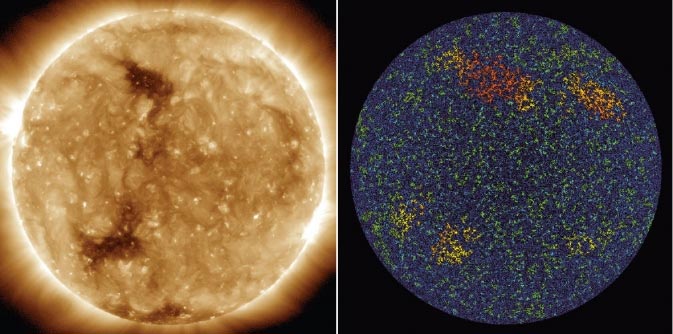Bright Points in Sun's Atmosphere Mark Patterns Deep In Its Interior

Brightpoints in the sun's atmosphere, left, correspond to magnetic parcels on the sun's surface, seen in the processed data on the right. Green spots show smaller parcels, red and yellow much bigger ones. Images based on data from NASA's SDO captured at 8 p.m. EDT on May 15, 2010. Image Credit: NASA/SDO
New research that uses data from NASA's Solar Dynamics Observatory, or SDO, to track bright points in the solar atmosphere and magnetic signatures on the sun's surface offers a way to probe the star's depths faster than ever before.
The technique opens the door for near real-time mapping of the sun's roiling interior – movement that affects a wide range of events on the sun from its 22-year sunspot cycle to its frequent bursts of X-ray light called solar flares.
“There are all sorts of things lurking below the surface,” said Scott McIntosh, first author of a paper on these results in the April 1, 2014, issue of The Astrophysical Journal Letters. “And we've found a marker for this deep rooted activity. This is kind of a gateway to the interior, and we don't need months of data to get there.”
One of the most common ways to probe the sun's interior is through a technique called helioseismology in which scientists track the time it takes for waves – not unlike seismic waves on Earth — to travel from one side of the sun to the other.
From helioseismology solar scientists have some sense of what's happening inside the sun, which they believe to be made up of granules and super-granules of moving solar material. The material is constantly overturning like boiling water in a pot, but on a much grander scale: A granule is approximately the distance from Los Angeles to New York City; a super-granule is about twice the diameter of Earth.
Instead of tracking seismic waves, the new research probes the solar interior using the Helioseismic Magnetic Imager on NASA's Solar Dynamics Observatory, or SDO, which can map the dynamic magnetic fields that thread through and around the sun. Since 2010, McIntosh has tracked the size of different magnetically-balanced areas on the sun, that is, areas where there are an even number of magnetic fields pointing down in toward the sun as pointing out.
Think of it like looking down at a city from above with a technology that observed people, but not walls, and recording areas that have an even number of men and women. Even without seeing the buildings, you'd naturally get a sense for the size of rooms, houses, buildings, and whole city blocks – the structures in which people naturally group.
The team found that the magnetic parcels they mapped corresponded to the size of granules and supergranules, but they also spotted areas much larger than those previously noted — about the diameter of Jupiter. It's as if when searching for those pairs of men and women, one suddenly realized that the city itself and the sprawling suburbs was another scale worth paying attention to. The scientists believe these areas correlate to even larger cells of flowing material inside the sun.
The researchers also looked at these regions in SDO imagery of the sun's atmosphere, the corona, using the Atmospheric Imaging Assembly instrument. They noticed that ubiquitous spots of extreme ultraviolet and X-ray light, known as brightpoints, prefer to hover around the vertices of these large areas, dubbed g-nodes.
“Imagine a bunch of helium balloons with weights on them,” said Robert Leamon, co-author on the paper at Montana State University in Bozeman and NASA Headquarters in Washington. “The weights get carried along by the motions at the bottom. We can track the motion of the helium balloons floating up high and that tells us what's happening down below.”
By opening up a way to peer inside the sun quickly, these techniques could provide a straightforward way to map the sun's interior and perhaps even improve our ability to forecast changes in magnetic fields that can lead to solar eruptions.
SDO is the first mission in NASA's Living with a Star program to explore aspects of the connected sun-Earth system that directly affect life and society. For more information about SDO and its mission, visit:
Karen C. Fox
NASA's Goddard Space Flight Center, Greenbelt, Md.
Media Contact
All latest news from the category: Physics and Astronomy
This area deals with the fundamental laws and building blocks of nature and how they interact, the properties and the behavior of matter, and research into space and time and their structures.
innovations-report provides in-depth reports and articles on subjects such as astrophysics, laser technologies, nuclear, quantum, particle and solid-state physics, nanotechnologies, planetary research and findings (Mars, Venus) and developments related to the Hubble Telescope.
Newest articles

First-of-its-kind study uses remote sensing to monitor plastic debris in rivers and lakes
Remote sensing creates a cost-effective solution to monitoring plastic pollution. A first-of-its-kind study from researchers at the University of Minnesota Twin Cities shows how remote sensing can help monitor and…

Laser-based artificial neuron mimics nerve cell functions at lightning speed
With a processing speed a billion times faster than nature, chip-based laser neuron could help advance AI tasks such as pattern recognition and sequence prediction. Researchers have developed a laser-based…

Optimising the processing of plastic waste
Just one look in the yellow bin reveals a colourful jumble of different types of plastic. However, the purer and more uniform plastic waste is, the easier it is to…


